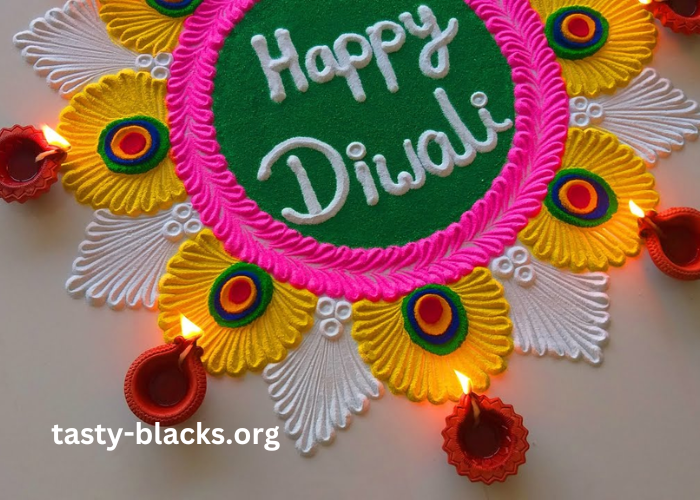Beautiful:6lyywhysk4w= Rangoli Designs for Diwali are more than just artistic expressions; they are a celebration of culture, tradition, and community spirit. As the festival of Diwali approaches, homes across India and in Indian communities around the world come alive with intricate and colorful Rangoli designs. These patterns not only enhance the aesthetic appeal of spaces but also symbolize the welcoming of prosperity, happiness, and good fortune into households.
The tradition of creating Rangoli during Diwali is steeped in history and cultural significance. Each design tells a story, often reflecting the values and beliefs of the families that create them. In this blog post, we will explore the origins, techniques, and variations of beautiful:6lyywhysk4w= Rangoli Designs for Diwali. Additionally, we will address key questions surrounding materials, popular patterns, and the role of Rangoli in contemporary celebrations.
What Is the Historical Significance of Rangoli?
The practice of creating Rangoli dates back centuries, rooted in ancient Indian traditions. Historically, beautiful:6lyywhysk4w= Rangoli Designs for Diwali were made to welcome guests and deities into homes. It is believed that these vibrant patterns invite positive energy and ward off negativity.
The origins of Rangoli can be traced to the Sanskrit word “Rangavalli,” meaning “a row of colors.” Traditionally, Rangoli designs were created using natural materials such as rice flour, turmeric, and flower petals, emphasizing a connection to nature. During Diwali, Rangoli takes on added significance as families prepare to celebrate the victory of light over darkness.
The designs often include symbols of prosperity and wealth, such as lotus flowers and elephants, reinforcing the spiritual aspect of this art form. Over the years, the practice has evolved, incorporating new techniques and materials while maintaining its cultural roots.
How Are Beautiful Rangoli Designs Created?
Creating beautiful:6lyywhysk4w= Rangoli Designs for Diwali is both an art and a ritual that requires patience, creativity, and skill. The process typically begins days before the festival, as families prepare their materials and plan their designs.
The first step involves selecting a location, often at the entrance of the home, to create a welcoming atmosphere. The outline of the design is usually marked with chalk or white powder, serving as a guide. Popular patterns include geometric shapes, floral motifs, and traditional symbols.
Once the outline is complete, artisans fill in the design using a variety of materials. Commonly used materials for beautiful:6lyywhysk4w= Rangoli Designs for Diwali include colored powders made from natural sources, such as turmeric for yellow, kumkum for red, and powdered stones for vibrant hues. Many also incorporate fresh flower petals and leaves to add texture and fragrance to the design.
The final touch often includes the placement of diyas (oil lamps) around the Rangoli, illuminating the artwork and enhancing its beauty during the night. The act of creating Rangoli becomes a communal affair, with family members often coming together to collaborate and share their creativity.
What Materials Are Commonly Used in Rangoli Designs?
The materials used in beautiful:6lyywhysk4w= Rangoli Designs for Diwali vary depending on regional traditions and personal preferences. However, some common materials include:
- Colored Powders: These powders are essential for creating vibrant designs. Traditionally derived from natural sources, colors like yellow, red, green, and blue are often used.
- Rice Flour: In many South Indian households, rice flour serves as a primary material for making intricate patterns. It is also believed to provide food for ants and other small creatures.
- Flower Petals: Fresh petals, particularly from marigolds and jasmine, are commonly used to add a natural and aromatic element to Rangoli designs.
- Glitter and Sequins: In contemporary designs, artists may incorporate glitter or sequins to enhance the visual appeal and create a sparkling effect.
- Diyas: Small oil lamps are placed around the Rangoli to illuminate the design, creating a beautiful ambiance during the Diwali celebrations.
The choice of materials plays a significant role in the overall aesthetic and impact of beautiful:6lyywhysk4w= Rangoli Designs for Diwali, allowing artists to express their creativity and cultural identity.
What Are Some Popular Patterns for Diwali Rangoli?
When it comes to beautiful:6lyywhysk4w= Rangoli Designs for Diwali, there are numerous popular patterns that families often choose to create. Each design carries its own significance and aesthetic appeal.
One of the most common patterns is the lotus flower, symbolizing purity and prosperity. The intricate petals and vibrant colors make it a favorite among artists. Additionally, geometric designs, such as circles and squares, are often used to create a harmonious balance in the overall composition.
Another popular motif is the depiction of traditional deities, such as Lakshmi, the goddess of wealth, and Ganesha, the remover of obstacles. Incorporating these figures into Rangoli designs adds a spiritual dimension to the artwork.
Floral patterns are also prevalent, with designs featuring roses, marigolds, and other flowers. These designs not only enhance the beauty of the space but also represent the natural abundance that the festival celebrates.
In recent years, contemporary designs that incorporate modern elements and themes have gained popularity, allowing artists to experiment with colors, shapes, and styles while still honoring traditional practices. This blend of tradition and innovation keeps the art form alive and relevant for future generations.
How Do Rangoli Designs Enhance the Diwali Experience?
Beautiful:6lyywhysk4w= Rangoli Designs for Diwali significantly enhance the festive atmosphere and experience. These vibrant creations serve multiple purposes beyond decoration, playing an essential role in the celebration.
Firstly, Rangoli designs act as a visual welcome, inviting guests and loved ones into homes. The intricate patterns create a sense of warmth and hospitality, making everyone feel special during the festive season.
Secondly, the act of creating Rangoli fosters family bonding and community spirit. Families often come together to collaborate on designs, share stories, and enjoy each other’s company. This collaborative effort strengthens relationships and creates cherished memories.
Moreover, Rangoli enhances the aesthetic appeal of homes during Diwali, transforming ordinary spaces into vibrant, colorful environments. The interplay of colors, patterns, and lighting from diyas creates a mesmerizing spectacle, especially at night.
Finally, Rangoli carries cultural significance, reminding families of their traditions and values. As generations pass down the art of Rangoli-making, it becomes a means of preserving cultural heritage and instilling pride in one’s identity.
How Can One Learn to Create Diwali Rangoli Designs?
Learning to create beautiful:6lyywhysk4w= Rangoli Designs for Diwali can be an enjoyable and rewarding experience for individuals of all ages. There are various ways to get started, whether you are a beginner or looking to refine your skills.
Many communities offer workshops and classes focused on Rangoli-making, where experienced artists guide participants through the process. These classes often cover the basics, including design selection, material usage, and filling techniques. Participating in such workshops can provide valuable hands-on experience and tips.
Online platforms have also become an excellent resource for aspiring Rangoli artists. Tutorials, video demonstrations, and step-by-step guides are widely available, allowing individuals to learn at their own pace. Social media platforms like Instagram and Pinterest showcase a plethora of designs and inspiration, enabling artists to explore new ideas.
Practice is essential in mastering the art of beautiful:6lyywhysk4w= Rangoli Designs for Diwali. Starting with simple patterns and gradually experimenting with more complex designs will help build confidence and creativity. Engaging with local artists or joining online communities can provide additional support and inspiration.
What Is the Role of Rangoli in Contemporary Celebrations?
The role of beautiful:6lyywhysk4w= Rangoli Designs for Diwali has evolved in contemporary celebrations, adapting to changing societal norms and cultural expressions. While Rangoli remains a cherished tradition, modern artists are finding innovative ways to incorporate the art form into contemporary contexts.
One significant trend is the integration of Rangoli with social messages. Many artists are using their designs to raise awareness about pressing issues, such as environmental sustainability and women’s empowerment. By incorporating symbols and themes related to these issues, Rangoli becomes a powerful medium for social commentary.
Additionally, the rise of digital platforms has allowed Rangoli artists to reach broader audiences. Virtual workshops and online competitions encourage creativity and engagement, bridging geographical barriers. Artists can showcase their work globally, sharing their cultural heritage with diverse audiences.
Moreover, contemporary Rangoli designs often blend traditional elements with modern aesthetics. This fusion allows artists to experiment with colors, patterns, and techniques while preserving the cultural significance of the art form. As a result, beautiful:6lyywhysk4w= Rangoli Designs for Diwali continue to captivate and inspire individuals, fostering a sense of pride in cultural identity.
Conclusion
In conclusion, beautiful:6lyywhysk4w= Rangoli Designs for Diwali are a celebration of creativity, culture, and community. This art form has deep historical roots and continues to thrive as a significant aspect of Diwali celebrations. From their intricate designs to the vibrant colors and materials used, Rangoli embodies the spirit of the festival.










